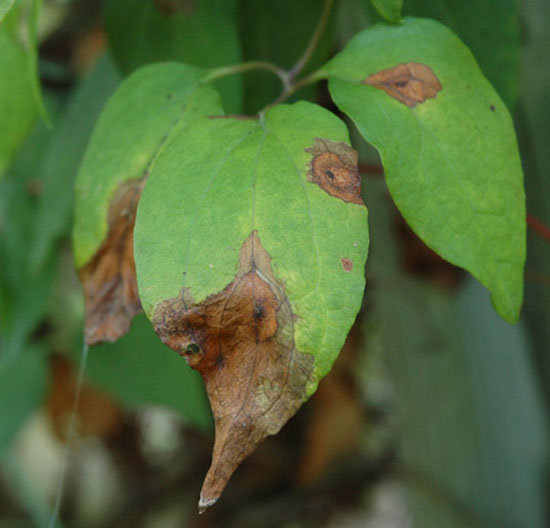Issue 13, July 31, 2009
Clematis Wilt
Clematis is host to a fungal leaf spot called Ascochyta leaf spot. The cause is a fungus, formerly called Ascochyta clematidina, but now known as Phoma clematidina. The image shows this leaf spot on lower leaves of my clematis this year.

Clematis wilt is the disease that occurs when this leaf spot fungus grows from the leaf to the stem, causing cankers and ultimately wilting of the plant. Clematis wilt is not a term that is intended to implicate a vascular wilt pathogen such as Verticillium. This clematis stem disease causes individual shoots to suddenly wilt and die. We do not always find the causal fungus on plant specimens sent to the Plant Clinic lab because often only the top portion of the stem is submitted. Look for small lesions at the soil line. The fruiting bodies of this fungus will appear as black, pin-head sized specks in the lesions.
When the plants are lush and full, any type of injury low on a stem seems to make whole sections of the plant wilt and not recover. When planting new clematis, plant them deeper than you might normally plant. You want at least two sets of opposite buds under the soil line. Dig the hole and lay the plant down while gently curving the stem at the right place to get two buds below the soil. It has been found that clematis planted in this manner have a much hardier root system and a better chance of recovering from stem blight. Make sure your clematis has adequate support. This will help minimize injuries to the stems caused by wind. Always be careful when working around clematis. Don't allow clematis to become water stressed. Water the soil rather than the foliage or water at a time when plants will dry quickly. Clematis species prefer neutral to slightly alkaline soil with lots of organic matter. The soil should be kept cool and evenly moist. Roots should be in shade or mulched.
If this stem disease is present in your plants, follow the above suggestions. At the end of this season, cut affected stems (or the entire plant) back to a few buds above the soil. Remove all stems and fallen leaves from the site. This should remove most of the inoculum from the site. Chemicals are not recommended, although in severe cases a fungicide with a general ornamental label (such as thiophanate methyl or copper sulfate products) may slow the disease progress.--Nancy Pataky
Author:
Nancy Pataky